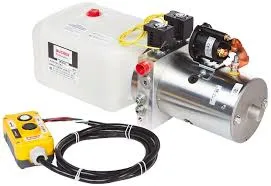Dec . 10, 2024 18:21 Back to list
Hydraulic Press Pump and Cylinder Solutions for Efficient Industrial Applications
Understanding Hydraulic Press Pumps and Cylinders
Hydraulic systems have become a cornerstone in various industries, from automotive manufacturing to construction. Among the vital components of these systems are hydraulic press pumps and cylinders, which work together to generate, transmit, and manage hydraulic energy. This article delves into the functionality, types, applications, and maintenance of hydraulic press pumps and cylinders.
What are Hydraulic Press Pumps and Cylinders?
Hydraulic press pumps are devices that convert mechanical energy into hydraulic energy by pressurizing hydraulic fluid. The core function of a hydraulic press pump is to create a flow of pressurized fluid that can operate hydraulic cylinders. These cylinders, in turn, convert the hydraulic energy back into mechanical energy, enabling the movement of heavy loads with precision and control.
A hydraulic cylinder consists of a cylindrical barrel, a piston, and end cap seals. When pressurized fluid enters one side of the piston, it generates force, causing the piston to extend or retract. This operation is pivotal in applications where heavy lifting or precise movements are needed.
Types of Hydraulic Press Pumps
There are various types of hydraulic press pumps, each designed for specific applications. The most common types include
1. Gear Pumps These are positive displacement pumps that transfer hydraulic fluid using the meshing of gears. They are common in low to medium-pressure applications and are known for their durability and ability to handle viscous fluids.
2. Vane Pumps These pumps use a series of vanes that slide in and out of a rotor to move fluid. Vane pumps are efficient and provide a smooth flow, making them suitable for gentle applications requiring variable flow rates.
3. Piston Pumps Piston pumps are highly efficient and can generate high pressure. They utilize pistons driven by a crankshaft to push hydraulic fluid. This type of pump is ideal for applications requiring high pressure over extended periods.
4. Hydrostatic Pumps These are specialized pumps that use fluid pressure to perform work. They are often used in hydrostatic drive systems, providing smooth, variable speed control.
Applications of Hydraulic Press Pumps and Cylinders
hydraulic press pump and cylinder products

The applications of hydraulic press pumps and cylinders are vast and varied. They are extensively used in
- Manufacturing In production lines, hydraulic presses are employed to shape, mold, or assemble components. They can exert massive forces, which are indispensable in metal forming processes such as stamping and forging.
- Construction Hydraulic cylinders play a critical role in heavy machinery like excavators, bulldozers, and cranes. They enable these machines to perform essential functions such as lifting, digging, and moving materials.
- Automotive Hydraulic systems are utilized in various automotive applications, including brake systems and lifts for servicing vehicles. They provide the necessary power to operate these functions efficiently.
- Aerospace In aircraft, hydraulic systems are integral to controlling flight surfaces and landing gear, offering reliable performance critical to safety.
Maintenance of Hydraulic Press Pumps and Cylinders
Proper maintenance is essential to ensure the longevity and efficiency of hydraulic press pumps and cylinders. Here are some key maintenance practices
1. Regular Fluid Checks Monitor hydraulic fluid levels and condition. Contaminated or low fluid levels can lead to pump failure or decreased system efficiency.
2. Inspect Seals and Hoses Over time, seals and hoses can wear out or become damaged, leading to leaks. Regular inspection and timely replacement are crucial to prevent fluid loss and maintain system pressure.
3. Filter Maintenance Hydraulic systems often have filters to catch contaminants. Regularly check and replace these filters to prevent clogging and ensure a smooth fluid flow.
4. Pressure Monitoring Utilize pressure gauges to monitor system pressure. Anomalies in pressure can indicate underlying issues, allowing for proactive troubleshooting.
In conclusion, hydraulic press pumps and cylinders are remarkable components that can handle extraordinary tasks across various sectors. Understanding their functionality, types, and applications allows users to optimize their use in practical scenarios, ensuring efficiency and effectiveness in hydraulic operations. Proper maintenance further enhances their resilience, preventing costly downtime and ensuring safety across all applications. As industries continue to evolve, the reliance on hydraulic systems will undoubtedly persist, prompting continuous improvements in technology and efficiency.
-
Fork Lift Power Units - Hebei Shenghan | Efficiency, Reliability
NewsJul.13,2025
-
1.5-Ton Turbocharged Cylinder-Hebei Shenghan|Hydraulic Solution,Energy Efficiency
NewsJul.13,2025
-
Auto Hoist Power Units-Hebei Shenghan|Efficiency&Industrial Lifting
NewsJul.13,2025
-
Double Acting Power Units-Hebei Shenghan|Hydraulic Solutions,Industrial Efficiency
NewsJul.13,2025
-
1.5 Ton Lifting Cylinder 70/82-40-290-535 - High-Performance Hydraulic Solution | Hebei Shenghan
NewsJul.13,2025
-
Fork Lift Power Units - Hebei Shenghan | Efficiency&Reliability
NewsJul.13,2025
